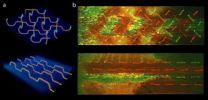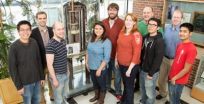(Press-News.org) Internal damage in fiber-reinforced composites, materials used in structures of modern airplanes and automobiles, is difficult to detect and nearly impossible to repair by conventional methods. A small, internal crack can quickly develop into irreversible damage from delamination, a process in which the layers separate. This remains one of the most significant factors limiting more widespread use of composite materials.
However, fiber-composite materials can now heal autonomously through a new self-healing system, developed by researchers in the Beckman Institute's Autonomous Materials Systems (AMS) Group at the University of Illinois at Urbana-Champaign, led by professors Nancy Sottos, Scott White, and Jeff Moore.
Sottos, White, Moore, and their team created 3D vascular networks—patterns of microchannels filled with healing chemistries—that thread through a fiber-reinforced composite. When damage occurs, the networks within the material break apart and allow the healing chemistries to mix and polymerize, autonomously healing the material, over multiple cycles. These results were detailed in a paper titled "Continuous self-healing life cycle in vascularized structural composites," published in Advanced Materials.
"This is the first demonstration of repeated healing in a fiber-reinforced composite system," said Scott White, aerospace engineering professor and co-corresponding author. "Self-healing has been done before in polymers with different techniques and networks, but they couldn't be translated to fiber-reinforced composites. The missing link was the development of the vascularization technique."
"The beauty of this self-healing approach is, we don't have to probe the structure and say, this is where the damage occurred and then repair it ourselves," said Jason Patrick, a Ph.D. candidate in civil engineering and lead author.
The vasculature within the system integrates dual networks that are isolated from one other. Two liquid healing agents (an epoxy resin and hardener) are sequestered in two different microchannel networks.
"When a fracture occurs, this ruptures the separate networks of healing agents, automatically releasing them into the crack plane—akin to a bleeding cut," Patrick said. "As they come into contact with one another in situ, or within the material, they polymerize to essentially form a structural glue in the damage zone. We tested this over multiple cycles and all cracks healed successfully at nearly 100 percent efficiency."
Notably, the vascular networks within the structure are not straight lines. In order for the healing agents to combine effectively after being released within the crack, the vessels were overlapped to further promote mixing of the liquids, which both have a consistency similar to maple syrup.
Fiberglass and other composite materials are widely used in aerospace, automotive, naval, civil, and even sporting goods because of their high strength-to-weight ratio—they pack a lot of structural strength into a very lean package. However, because the woven laminates are stacked in layers, it is easier for the structure to separate between the layers, making this self-healing system a promising solution to a long-standing problem and greatly extending their lifetime and reliability.
"Additionally, creating the vasculature integrates seamlessly with typical manufacturing processes of polymer composites, making it a strong candidate for commercial use," said Nancy Sottos, materials science and engineering professor and co-corresponding author.
Fiber-composite laminates are constructed by weaving and stacking multiple layers of reinforcing fabric, which are then co-infused with a binding polymer resin. Using that same process, the researchers stitched in a sort of fishing line, made from a bio-friendly polymer and coined "sacrificial fiber," within the composite. Once the composite was fabricated, the entire system was heated to melt and evaporate the sacrificial fibers, leaving behind hollow microchannels, which became the vasculature for the self-healing system.
INFORMATION:
This work was supported by the Air Force Office of Scientific Research, the Department of Homeland Security Center of Excellence for Explosives Detection, Mitigation, and Response, and the Army Research Laboratory. Jeff Moore, Kevin Hart, Brett Krull, and Charles Diesendruck were also co-authors on the paper.
Repeated self-healing now possible in composite materials
2014-04-15
ELSE PRESS RELEASES FROM THIS DATE:
Changes in processing, handling could reduce commercial fishing injuries
2014-04-15
CORVALLIS, Ore. – Handling frozen fish caused nearly half of all injuries aboard commercial freezer-trawlers and about a quarter of the injuries on freezer-longliner vessels operating off the coast of Alaska, new research from Oregon State University shows.
Many of those injuries and others aboard the two types of vessels could be prevented with the right interventions, and the research methods used in the study could help identify and reduce injuries and fatalities in other types of commercial fishing, said researcher Devin Lucas. His findings were published in the American ...
Potent, puzzling and (now less) toxic: Team discovers how antifungal drug works
2014-04-15
CHAMPAIGN, Ill. — Scientists have solved a decades-old medical mystery – and in the process have found a potentially less toxic way to fight invasive fungal infections, which kill about 1.5 million people a year. The researchers say they now understand the mechanism of action of amphotericin, an antifungal drug that has been in use for more than 50 years – even though it is nearly as toxic to human cells as it is to the microbes it attacks.
A report of the new findings appears in Nature Chemical Biology.
"Invasive fungal infections are a very important unmet medical ...
Long-term predictions for Miami sea level rise could be available relatively soon
2014-04-15
Miami could know as early as 2020 how high sea levels will rise into the next century, according to a team of researchers including Florida International University scientist Rene Price.
Price is also affiliated with the National Science Foundation's (NSF) Florida Coastal Everglades Long-Term Ecological Research (LTER) site, one of 25 such NSF LTER sites in ecosystems from coral reefs to deserts, mountains to salt marshes around the world.
Scientists conclude that sea level rise is one of the most certain consequences of climate change.
But the speed and long-term ...
Study: SSRI use during pregnancy associated with autism and developmental delays in boys
2014-04-15
In a study of nearly 1,000 mother-child pairs, researchers from the Bloomberg School of Public health found that prenatal exposure to selective serotonin reuptake inhibitors (SSRIs), a frequently prescribed treatment for depression, anxiety and other disorders, was associated with autism spectrum disorder (ASD) and developmental delays (DD) in boys. The study, published in the online edition of Pediatrics, analyzed data from large samples of ASD and DD cases, and population-based controls, where a uniform protocol was implemented to confirm ASD and DD diagnoses by trained ...
Astronomers: 'Tilt-a-worlds' could harbor life
2014-04-15
A fluctuating tilt in a planet's orbit does not preclude the possibility of life, according to new research by astronomers at the University of Washington, Utah's Weber State University and NASA. In fact, sometimes it helps.
That's because such "tilt-a-worlds," as astronomers sometimes call them — turned from their orbital plane by the influence of companion planets — are less likely than fixed-spin planets to freeze over, as heat from their host star is more evenly distributed.
This happens only at the outer edge of a star's habitable zone, the swath of space around ...
Vitamin D deficiency contributes to poor mobility among severely obese people
2014-04-15
Washington, DC—Among severely obese people, vitamin D may make the difference between an active and a more sedentary lifestyle, according to a new study published in the Endocrine Society's Journal of Clinical Endocrinology & Metabolism (JCEM).
The study found severely obese people who also were vitamin D-deficient walked slower and were less active overall than their counterparts who had healthy vitamin D levels. Poor physical functioning can reduce quality of life and even shorten lifespans.
Severe obesity occurs when a person's body mass index (BMI) exceeds 40. About ...
Osteoporosis risk heightened among sleep apnea patients
2014-04-15
Washington, DC—A diagnosis of obstructive sleep apnea may raise the risk of osteoporosis, particularly among women or older individuals, according to a new study published in the Endocrine Society's Journal of Clinical Endocrinology & Metabolism (JCEM).
Sleep apnea is a condition that causes brief interruptions in breathing during sleep. Obstructive sleep apnea, the most common form, occurs when a person's airway becomes blocked during sleep. If sleep apnea goes untreated, it can raise the risk for stroke, cardiovascular disease and heart attacks.
"Ongoing sleep disruptions ...
Can refined categorization improve prediction of patient survival in RECIST 1.1?
2014-04-15
In a recent analysis by the RECIST Working Group published in the European Journal of Cancer, EORTC researchers had explored whether a more refined categorization of tumor response or various aspects of progression could improve prediction of overall survival in the RECIST database. They found that modeling target lesion tumor growth did not improve the prediction of overall survival above and beyond that of the other components of progression. The RECIST Working Group includes the EORTC, the United States National Cancer Institute, and the National Cancer Institute of ...
Calcium score predicts future heart disease among adults with little or no risk factors
2014-04-15
LOS ANGELES – (April 15, 2014) – With growing evidence that a measurement of the buildup of calcium in coronary arteries can predict heart disease risk, Los Angeles Biomedical Research Institute (LA BioMed) researchers found that the process of "calcium scoring" was also accurate in predicting the chances of dying of heart disease among adults with little or no known risk of heart disease.
Previous studies had found that calcium scores were effective in predicting heart disease among adults with known heart disease risk factors, such as hypertension, diabetes, dyslipidemia, ...
Earthquake simulation tops 1 quadrillion flops
2014-04-15
This news release is available in German. Geophysicists use the SeisSol earthquake simulation software to investigate rupture processes and seismic waves beneath the Earth's surface. Their goal is to simulate earthquakes as accurately as possible to be better prepared for future events and to better understand the fundamental underlying mechanisms. However, the calculations involved in this kind of simulation are so complex that they push even super computers to their limits.
In a collaborative effort, the workgroups led by Dr. Christian Pelties at the Department of ...




